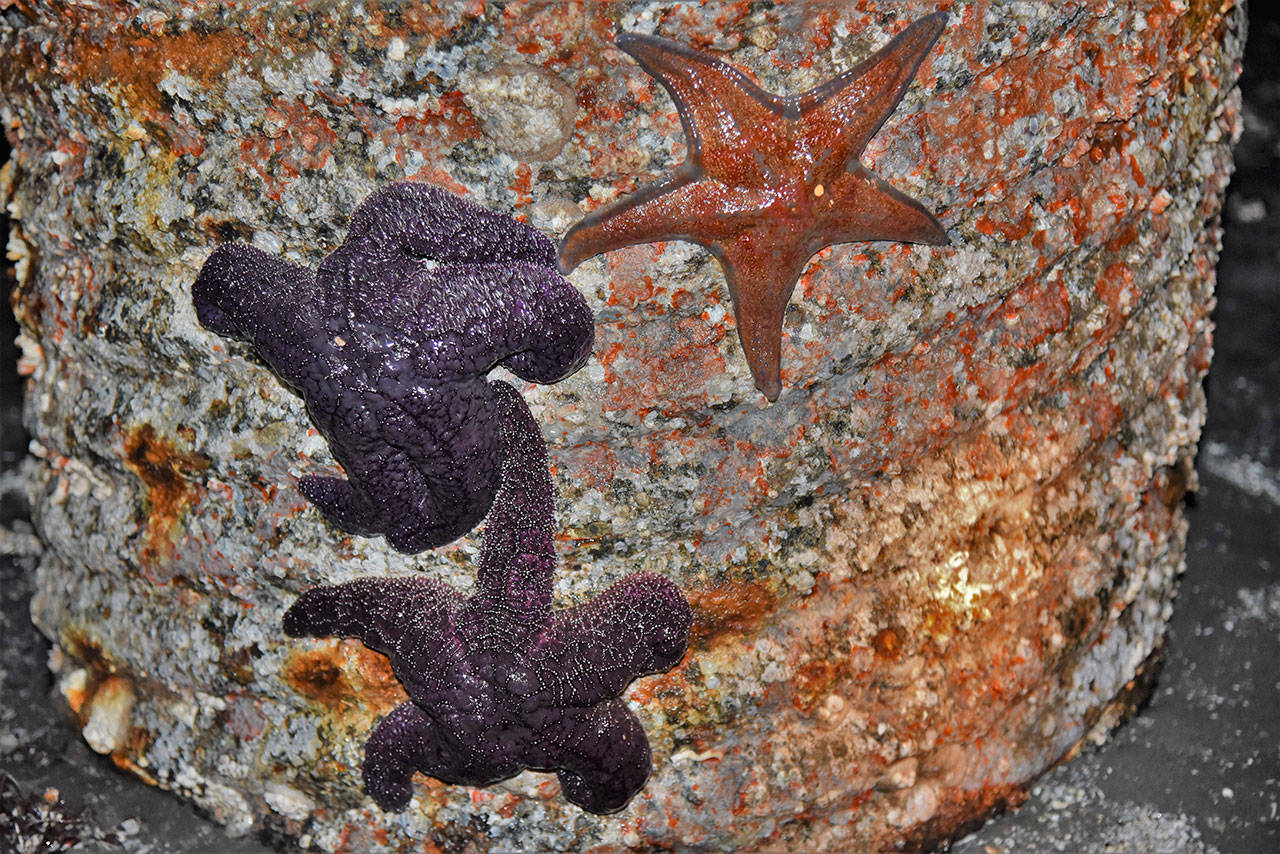Marine life lovers had cause to rejoice last week as a story raced across the media landscape from the AP newswire: Sea Stars, beloved and iconic of West-coastal tidal life and whose populations were decimated by a die-off event in 2013-14, were making a come back.
“They are coming back, big time,” an aquarist from Los Angeles was quoted as saying.
Sounds promising, right? News outlets from California, all the way up the coast to British Columbia ran the story.
Not so fast.
The Beachcomber connected with staff from the Multi-Agency Rocky Intertidal Network (MARINe) — a large consortium of research groups working together to collect data that are entered into a centralized database and based out of the University of California-Santa Cruz — regarding the news.
“I spoke to our colleagues in Southern California,” Melissa Miner, research associate/data manager and Washington regional coordinator for MARINe, said. “They haven’t seen any evidence of recruitment at their sites (which are monitored regularly). In general, we have seen very little recruitment or recovery south of central California, and in Washington, it seems like most stars aren’t making it to the adult stage. Numbers are still way down from pre-Sea Star Wasting Disease (SSWD) levels.”
That didn’t sound promising at all.
“Recruitment” is the term used when young sea stars or “recruits” settle down somewhere to grow into adult stars. Sea star age is determined by size (diameter). Given that the initial story was based on “palm-sized” stars being observed in some Southern California tide pools, what that means really depends on whose palms you’re talking about.
Sea stars historically have been observed to experience die-off events practically once per decade. But the SSWD event of 2013-14 is the largest, most wide-spread and longest that has been observed to date. The disease is thought to be due, at least in part, to a virus, and possibly exacerbated in some areas by warmer temperatures (according to Miner, the jury is still out on the role of temperature in this event, though it has certainly been a factor in some localized events in the past). The disease is brutal — literally melting the arms off the colorful, celestially-monikered creatures before they completely disintegrate into piles of goo. This event wiped out nearly entire populations of most species of sea stars from Mexico to Alaska.
Jeff Adams, an islander and marine ecologist for the University of Washington’s Sea Grant program, spoke to The Beachcomber about what he’s seen locally.
“Maybe three years ago, right after the die-off, we were seeing lots of tiny ones,” he said. “We were initially optimistic. But a few months later, we weren’t seeing any.”
He added that a couple of years back, just before construction began on the north-end ferry dock, people could still find stars on the dock’s pilings. Now, he said, there are essentially none.
“In the past, these events have only lasted through a season,” Adams recalled. “Now, we’ve seen two to three years of active die off and have gone three years now without seeing them bounce back.”
One aspect of the situation that he noted was “neat to see” is the citizen data collection that SSWD has led to, particularly on Vashon.
Islander, Rayna Holtz, is one of those data-collecting citizens.
“My best sense of it comes from 12 years of walking the beaches here for a UW citizen science project,” she explained. “But that was for counting dead sea birds, and we never see any dead sea birds … so we started counting sea stars instead.”
“My take on what we’ve seen to this point is, that sea star wasting disease hit Vashon early and hard,” Holtz noted. “And even though we had some young stars appearing, indicating possible recovery in 2015 and 2016, they are still very much depleted — or non-existent in number at most sites. I didn’t see many juvenile stars this year and only a few mid-sized ones.”
And the Vashon Nature Center’s Bianca Perla has been working for the past three years with Vashon High School students to monitor the sea star populations at eight different beach sites around the island.
“Since 2014, across all sites we’ve seen a 75 percent drop in sea star counts,” she said of their observations.
Perla also said that she and the students will repeat their surveys again this spring so they can compare the data with what’s being reported in other areas.
While “coming back big time” doesn’t appear to hold true according to the experts and local observers, Perla was able to offer a positive note:
“It’s been great to have such support from the schools for getting students out on the beach, helping us with these surveys and contributing to a larger, regional effort to track this disease,” she said.
For more information and updates on SSWD, see sea starwasting.org.



